Apollo 17 was the last mission to land people on the Moon. It ran Dec. 7–19, 1972. 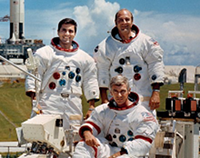
Commanding the crew was Gene Cernan (right, seated). Joining Cernan on the lunar surface was Lunar Module Pilot Harrison Schmitt (right, left). Orbiting the Moon while those were on the Moon was Command Module Pilot Ron Evans (right, right). The crew named their Command Module America and their Lunar Module Challenger. As did the Apollo 15 and Apollo 16 crews, Cernan, Evans, and Schmitt undertook extensive geological training, including field trips to various rock formations in Canada. Schmitt was a professional geologist 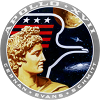
Launch date was Dec. 7, 1972. On the way to the Moon, the Apollo 17 astronauts repeated an experiment done by the Apollo 16 crew. Crews as far back as Apollo 11 had reported seeing light flashes in the dark of space, even when they had their eyes shut. The crew wore a special helmet that was designed to track the movements of cosmic rays. Subsequent analysis proved NASA's theory that the astronauts were indeed observing cosmic rays. The trip to the Moon was otherwise uneventful. The Lunar Module landed in the Taurus-Littrow valley, somewhere no previous crew had been. Cernan was the first to set foot on the surface; Schmitt followed. 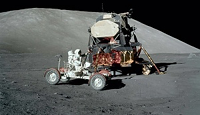
As before, the lunar surface crew took samples of lunar dust and rocks. They also set up scientific instruments. One of the most high-profile instruments was the Traverse Gravimeter Experiment (TGE). The astronauts took gravity measurements at their landing site and at several other points in their travels. (They had use of the Rover vehicle, as had their two predecessors.) The focus of the data back on Earth would be geology. Another geologic instrument deployed was the lunar sounder, which beamed electromagnetic pulses at the lunar surface; scientists hoped to use this data to help built a geological model of the Moon's interior. 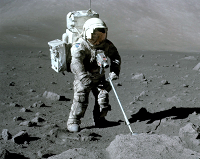
An instrument with a slightly different purpose was the infrared scanning radiometer, which made a temperature map of the lunar surface in order to better locate fields of rocks and find differences in the crust structure. Another experiment done only on Apollo 17 was the Surface Electrical Properties (SEP) experiment. The crew placed a transmitting antenna near their landing module and then used the receiving antenna on the lunar rover to send electrical signals through the ground back to the antenna near the lunar module. The idea was to determine the electrical properties of the lunar soil. Channeling certain missions done by the Soviet space program, the Apollo 17 crew carried with them five pocket mice, equipped with radiation monitors. Each mouse had an alphanumeric name, but the crew nicknamed them "Fe," "Fi," "Fo," "Fum," and "Phooey." Four of the five mice survived the journey, and scientists later found that the mice showed no signs of ill effects from the journey. 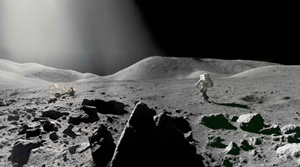
The astronauts performed three EVAs in all. When it was time to leave, they reversed their order; thus, Cernan was the last to walk on the Moon. Their rendezvous with Evans in the Command Module proceeded without incident, as did the return to Earth, during which Evans conducted a 67-minute EVA to recover film in an exterior camera. They splashed down on December 19. |
|
Social Studies for Kids
copyright 2002–2025
David White




